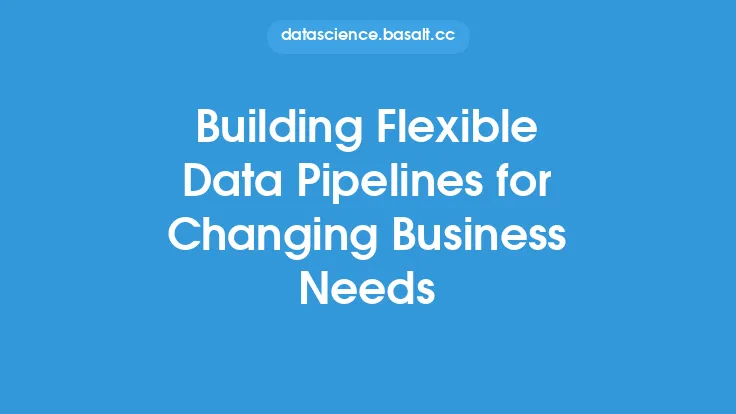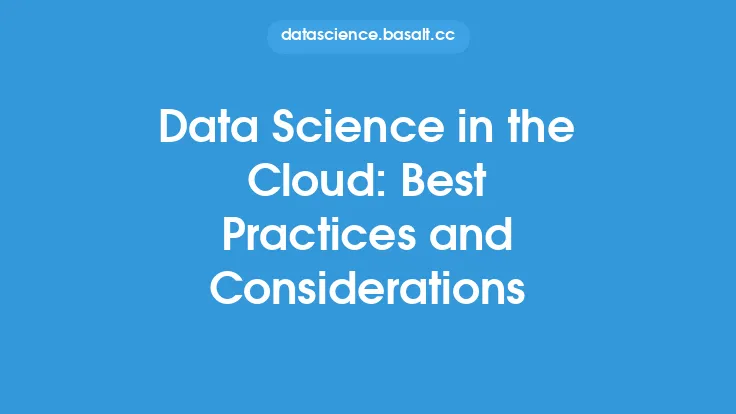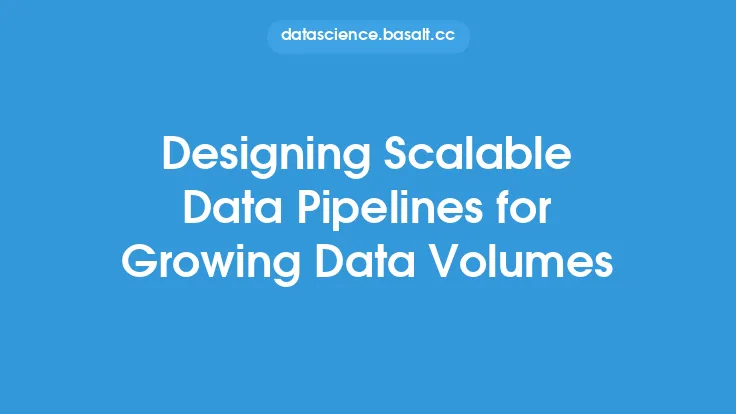Building scalable data pipelines in the cloud is a crucial aspect of data engineering, as it enables organizations to handle large volumes of data from various sources, process them efficiently, and make data-driven decisions. With the increasing amount of data being generated every day, it's essential to design data pipelines that can scale horizontally and vertically to meet the growing demands. In this article, we'll delve into the world of cloud-based data pipelines, exploring the key concepts, architectures, and best practices for building scalable and efficient data pipelines.
Introduction to Data Pipelines
A data pipeline is a series of processes that extract data from multiple sources, transform it into a usable format, and load it into a target system for analysis or storage. Data pipelines can be simple or complex, depending on the use case, and may involve various technologies, such as data ingestion tools, data processing frameworks, and data storage systems. In the context of cloud computing, data pipelines can be designed to take advantage of scalable infrastructure, on-demand resources, and managed services, making it easier to build and maintain large-scale data pipelines.
Cloud-Based Data Pipeline Architecture
A typical cloud-based data pipeline architecture consists of several components, including:
- Data Ingestion: This layer is responsible for collecting data from various sources, such as logs, social media, IoT devices, or databases. Popular data ingestion tools include Apache Kafka, Amazon Kinesis, and Google Cloud Pub/Sub.
- Data Processing: This layer transforms, aggregates, and processes the ingested data using frameworks like Apache Spark, Apache Flink, or Apache Beam. Data processing can be done in batch or real-time, depending on the use case.
- Data Storage: This layer stores the processed data in a scalable and durable manner, using solutions like Amazon S3, Google Cloud Storage, or Azure Blob Storage.
- Data Analytics: This layer provides insights and visualizations using data analytics tools like Apache Hive, Presto, or Amazon Redshift.
Designing Scalable Data Pipelines
To build scalable data pipelines, consider the following design principles:
- Decoupling: Separate the data ingestion, processing, and storage layers to allow for independent scaling and maintenance.
- Microservices Architecture: Break down the data pipeline into smaller, independent services that can be developed, deployed, and scaled separately.
- Event-Driven Architecture: Use event-driven design patterns to handle data ingestion and processing, enabling real-time processing and scalability.
- Auto-Scaling: Use cloud provider's auto-scaling features to dynamically adjust the number of resources based on workload demands.
- Monitoring and Logging: Implement comprehensive monitoring and logging to detect issues, optimize performance, and improve data quality.
Choosing the Right Cloud Services
When building scalable data pipelines in the cloud, it's essential to choose the right services that meet your specific needs. Consider the following cloud services:
- Amazon Web Services (AWS): AWS offers a wide range of services, including Amazon Kinesis, Amazon S3, Amazon Redshift, and AWS Glue.
- Microsoft Azure: Azure provides services like Azure Event Hubs, Azure Blob Storage, Azure Data Lake Storage, and Azure Databricks.
- Google Cloud Platform (GCP): GCP offers services like Google Cloud Pub/Sub, Google Cloud Storage, Google Cloud Dataflow, and Google BigQuery.
Best Practices for Building Scalable Data Pipelines
To ensure the scalability and reliability of your data pipelines, follow these best practices:
- Test and Validate: Thoroughly test and validate your data pipeline to ensure it can handle large volumes of data and scale as needed.
- Implement Data Quality Checks: Implement data quality checks to detect and handle errors, inconsistencies, and data corruption.
- Use Cloud-Native Services: Leverage cloud-native services that are designed for scalability, reliability, and performance.
- Monitor and Optimize: Continuously monitor your data pipeline's performance and optimize it as needed to ensure efficient resource utilization.
- Document and Version: Document your data pipeline architecture and version your code to ensure reproducibility and maintainability.
Security and Governance Considerations
When building scalable data pipelines in the cloud, it's crucial to consider security and governance aspects, such as:
- Data Encryption: Encrypt data in transit and at rest to ensure confidentiality and integrity.
- Access Control: Implement role-based access control and authentication mechanisms to restrict access to sensitive data.
- Data Governance: Establish data governance policies and procedures to ensure data quality, compliance, and regulatory adherence.
- Compliance: Ensure compliance with relevant regulations, such as GDPR, HIPAA, or PCI-DSS, when handling sensitive data.
Conclusion
Building scalable data pipelines in the cloud requires careful planning, design, and implementation. By following the principles and best practices outlined in this article, you can create efficient, reliable, and scalable data pipelines that meet the growing demands of your organization. Remember to choose the right cloud services, implement security and governance measures, and continuously monitor and optimize your data pipeline to ensure optimal performance and data quality. With the ever-increasing amount of data being generated, building scalable data pipelines in the cloud is essential for organizations to stay competitive and make data-driven decisions.





